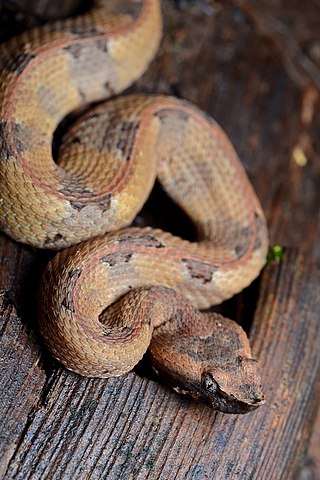
Loxocemus bicolor, the sole member of the monotypic family Loxocemidae and commonly known as the Mexican python, Mexican burrowing python and Mexican burrowing snake, is a species of python-like snake found in Mexico and Central America. No subspecies are currently recognized. Analyses of DNA show that Loxocemus is most closely related to the true pythons and the sunbeam snakes.

Amerotyphlops brongersmianus, known commonly as Brongersma's worm snake or the South American striped blindsnake, is a species of harmless blind snake in the family Typhlopidae. The species is native to South America and Trinidad and Tobago in the Caribbean. No subspecies are currently recognized.

Amerotyphlops trinitatus, known commonly as the Trinidad blindsnake, Trinidad worm snake, and Trinidad burrowing snake, is a harmless blind snake species in the family Typhlopidae. The species is endemic to Trinidad and Tobago. There are no subspecies that are recognized as being valid.

Typhlops is a genus of blind snakes in the family Typhlopidae. The genus is endemic to the West Indies. Some species which were formerly placed in the genus Typhlops have been moved to the genera Afrotyphlops, Amerotyphlops, Anilios, Antillotyphlops, Argyrophis, Cubatyphlops, Indotyphlops, Letheobia, Madatyphlops, Malayotyphlops, and Xerotyphlops.

Adelphicos quadrivirgatum, the Middle American burrowing snake, is a species of dipsadine colubrid snake, endemic to Mexico and Central America.

Bothriechis bicolor is a venomous pit viper species found in southern Mexico, Guatemala and Honduras. The specific name refers to the contrasting ventral and dorsal colors. No subspecies are currently recognized.

Bothriechis aurifer is a venomous pit viper species found in Mexico and Guatemala. No subspecies are currently recognized.

Porthidium nasutum is a venomous pitviper species found in southern Mexico, Central America and northern South America. No subspecies are currently recognized.

Metlapilcoatlus mexicanus is a venomous pitviper species endemic to Mexico and Central America.
Metlapilcoatlus occiduus is a venomous pitviper subspecies endemic to southern Mexico, Guatemala, and El Salvador.
Stejneger's beaked snake is a species of snake in the family Typhlopidae. The species is native to Middle Africa.
The Costa Rica worm snake is a species of snake in the Typhlopidae family.
The Cayman Brac blind snake is a species of snake in the family Typhlopidae.
The Puerto Rican worm snake is a species of snake in the Typhlopidae family.
Typhlops hectus is a species of snake in the family Typhlopidae. It is endemic to southwestern Haiti and is known from the Tiburon Peninsula and the island of Grand Cayemite, with an isolated record from Gonâve Island. Specimens of uncertain status are known further northeast, in an area extending into the Dominican Republic; whether these belong to Typhlops hectus or an undescribed species is pending further investigations.
The Estado Falcón worm snake is a species of snake in the family Typhlopidae. The species is endemic to Venezuela.
The Yucatán worm snake is a species of snake in the Typhlopidae family.
The Hispaniola worm snake is a species of snake in the Typhlopidae family.
The Haitian worm snake is a species of snake in the Typhlopidae family.
The titan worm snake is a species of snake in the Typhlopidae family.









